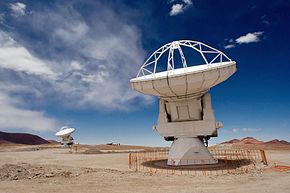
Back مصفوف مرصد أتاكاما المليمتري الكبير Arabic Atacama Large Millimeter Array AST আতাকামা লার্জ মিলিমিটার অ্যারে Bengali/Bangla Atacama Large Millimeter Array Catalan Atacama Large Millimeter Array Czech Atacama Large Millimeter Array Danish Atacama Large Millimeter/submillimeter Array German Μεγάλη Χιλιοστομετρική Διάταξη της Ατακάμα Greek ALMA (radioteleskopo) EO Atacama Large Millimeter Array Spanish
 | |
| Alternative names | Atacama Large Millimeter and Submillimeter Array |
|---|---|
| Part of | Event Horizon Telescope Llano de Chajnantor Observatory |
| Location(s) | Atacama Desert, Antofagasta Region, Atacama Desert, Chile |
| Coordinates | 23°01′09″S 67°45′12″W / 23.0193°S 67.7532°W |
| Organization | European Southern Observatory National Institutes of Natural Sciences, Japan National Science Foundation |
| Altitude | 5,058.7 m (16,597 ft) |
| Built | March 2013 |
| Telescope style | radio interferometer |
| Website | www |
| | |
The Atacama Large Millimeter/submillimeter Array (ALMA) is an astronomical interferometer of 66 radio telescopes in the Atacama Desert of northern Chile, which observe electromagnetic radiation at millimeter and submillimeter wavelengths. The array has been constructed on the 5,000 m (16,000 ft) elevation Chajnantor plateau – near the Llano de Chajnantor Observatory and the Atacama Pathfinder Experiment. This location was chosen for its high elevation and low humidity, factors which are crucial to reduce noise and decrease signal attenuation due to Earth's atmosphere.[1] ALMA provides insight on star birth during the early Stelliferous era and detailed imaging of local star and planet formation.[2][3]
ALMA is an international partnership amongst Europe, the United States, Canada, Japan, South Korea, Taiwan, and Chile.[4] Costing about US$1.4 billion, it is the most expensive ground-based telescope in operation.[5][6] ALMA began scientific observations in the second half of 2011 and the first images were released to the press on 3 October 2011. The array has been fully operational since March 2013.[7][8]
- ^ Bustos, R.; Rubio, M.; Otárola, A.; et al. (2014). "Parque Astronómico de Atacama: An Ideal Site for Millimeter, Submillimeter, and Mid-Infrared Astronomy". Publications of the Astronomical Society of the Pacific. 126 (946): 1126. arXiv:1410.2451. Bibcode:2014PASP..126.1126B. doi:10.1086/679330. S2CID 118539242.
- ^ Bae, Jaehan; Teague, Richard; Andrews, Sean M.; Benisty, Myriam; Facchini, Stefano; Galloway-Sprietsma, Maria; Loomis, Ryan A.; Aikawa, Yuri; Alarcón, Felipe; Bergin, Edwin; Bergner, Jennifer B.; Booth, Alice S.; Cataldi, Gianni; Cleeves, L. Ilsedore; Czekala, Ian; Guzmán, Viviana V.; Huang, Jane; Ilee, John D.; Kurtovic, Nicolas T.; Law, Charles J.; Gal, Romane Le; Liu, Yao; Long, Feng; Ménard, François; Öberg, Karin I.; Pérez, Laura M.; Qi, Chunhua; Schwarz, Kamber R.; Sierra, Anibal; Walsh, Catherine; Wilner, David J.; Zhang, Ke (1 August 2022). "Molecules with ALMA at Planet-forming Scales (MAPS): A Circumplanetary Disk Candidate in Molecular-line Emission in the AS 209 Disk". The Astrophysical Journal Letters. 934 (2): L20. arXiv:2207.05923. Bibcode:2022ApJ...934L..20B. doi:10.3847/2041-8213/ac7fa3. S2CID 250492936.
- ^ Plait, Phil (8 September 2022). "A still-forming exoplanet predicted to exist is found in exactly the right spot". SYFY Official Site.
- ^ Long, Gideon (29 May 2016). "Alma telescope peers into space from Chile's mountains". BBC News. Retrieved 29 May 2016.
- ^ "ALMA Inauguration Heralds New Era of Discovery". ESO - European Southern Observatory. 13 March 2013. Retrieved 29 April 2014.
- ^ Romero, Simon (7 April 2012). "At the End of the Earth, Seeking Clues to the Universe". The New York Times. Retrieved 8 April 2012.
- ^ Hernandez, Vladimir (2013-03-13). "Alma telescope: Ribbon cut on astronomical giant". BBC News. BBC. Retrieved 13 March 2013.
- ^ Spie (2014). "Pierre Cox plenary: ALMA Update". SPIE Newsroom. doi:10.1117/2.3201407.14.
